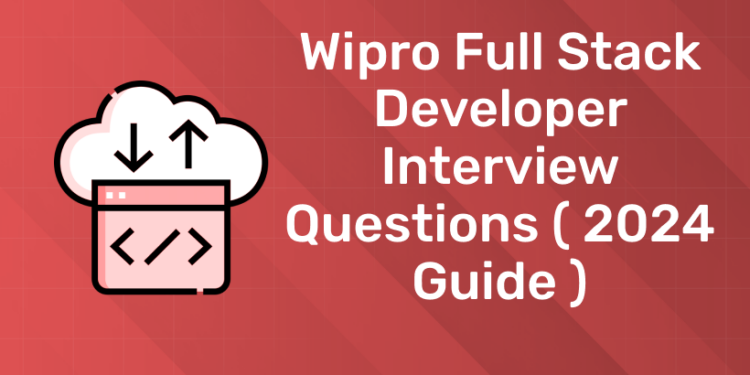Table of Contents
Wipro is a reputed Indian multinational company that provides consulting services. If you want a chance to work at Wipro, you need to prepare for interviews. This article will help you better understand Wipro interview questions commonly asked by employers.
About Wipro
Wipro is an Indian multinational corporation engaged in consulting, business process and information technology related services. Founded in 1945, it is headquartered in Bengaluru, India. Its capabilities extend into the areas of cloud computing, cybersecurity, artificial intelligence, robotics, digital transformation and data analytics. It also produces lighting, personal care and health products. In 2021, Wipro’s revenue exceeded $9. 8 billion.
Wipro Interview Questions
1: Which of the following is a JavaScript framework/library?
2: What is the purpose of CSS in web development?
3: What does CRUD stand for in web development?
4: Which of the following is a popular CSS framework?
5: Which technology is commonly used for asynchronous communication between the client and server?
Ever wondered how much you really know? It's time to put your brain to the test!
Experience the power of our full stack development course with a free demo – enroll now!
1. What is SQL Profiler?
SQL Profiler software allows us to monitor SQL Server connections and identify actions such as running SQL scripts, failed tasks, etc. SQL databases and their environments are monitored, analyzed, troubleshooted, and tuned using this tool.
2. What are the benefits of Hybrid Clouds in Cloud Computing?
There are two agendas in every technology management organization: the IT agenda and the business transformation agenda. Traditionally, the IT agenda has focused on cost reduction. On the other hand, corporate digital transformation plans focus on profitability through investments.
The main advantage of hybrid cloud is its flexibility. To gain the agility needed to gain a competitive advantage, your business may want (or need) to integrate public clouds, private clouds, and on-premises resources.
3. Describe the main differences between the LocalStorage and SessionStorage objects in context to HTML.
- Data stored in a localStorage object does not have an expiration date. On the other hand, the sessionStorage object stores data from a single session.
- When the browser window is closed, the data in the localStorage object is not deleted. However, in the case of sessionStorage objects, the data is destroyed when the browser window is closed.
- SessionStorage data is only available in the current browser window. On the other hand, data from localStorage can be shared across multiple browser windows.
4. What makes a macro faster than a function in the C programming language?
Code 1:
//C
#include<stdio.h>
#include<conio.h>
#define HRS 24 //Macro
int main()
{
printf("%d", HRS);
return 0;
} Output:
24Explanation:
In the above code, we have defined a macro named HRS whose value is 24. By calling the macro in the printf function, we can output a value of 24 on the terminal.
The above code can be deduced as the following code without using macros.
Code 2:
//C
#include<stdio.h>
int hrs()
{
return 24;
}
int main()
{
printf("%d", hrs()); //calling
return 0;
} Output :
24Explanation:
Here we have defined a function called HRS. When we call the HRS function in the printf function, the function returns 24 and hence 24 is printed on the output device.
Macros are preprocessed, which means all macros are processed before the code is compiled and functions are processed after the code is compiled.
Experience the power of our full stack development course with a free demo – enroll now!
5. What are the differences between an object-oriented programming language and object-based programming language?
- Object-oriented languages comply with all object-oriented programming concepts, but object-based languages do not comply with all object-oriented programming concepts such as inheritance, polymorphism, etc.
- Object-oriented languages lack built-in objects, but based languages do.
For example, JavaScript contains a built-in window object.
6. What do you understand about Stack Unwinding in C++?
7. Explain free() vs delete () in C++.
- The free() function is a C library function that can also be used in C++, while the “delete” keyword is a C++ keyword.
- The delete operator deletes a pointer allocated using the new operator or a NULL pointer, while the free() function deletes a pointer allocated using malloc(), the calloc() or realloc() function, or a pointer NULL..
- The delete operator in C++ calls the class destructor when it destroys the allocated memory, not the free() function; this simply frees heap memory.
8. Explain copy constructor and assignment operator in C++.
A copy constructor is a member function that uses another object of the same class to instantiate an object. The assignment operator is used to assign a value to a variable. The left operand of the assignment operator is a variable, while the right operand of the assignment operator is a value.
// C++
#include<iostream>
#include<stdio.h>
using namespace std;
class IB
{
public:
IB() {}
IB(const IB &b)
{
cout<<"Copy constructor is called "<<endl;
}
IB& operator = (const IB &b)
{
cout<<"Assignment operator is called "<<endl;
return *this;
}
};
// Driver code
int main()
{
IB b1, b2;
b2 = b1;
IB b3 = b1;
getchar();
return 0;
} Output:
Assignment operator is called
Copy constructor is calledWhen a new object is created from an existing object as a copy of the old object, the copy constructor is called. When an initialized object receives a new value from another object, the assignment operator is used.
9. Get the nth Fibonacci number in O(n) time and O(1) space complexity.
//Javascript
function fib(n){
let [x, y] = [0, 1]
while (n > 0){
[x, y] = [y, x + y]
n -= 1
}
return x
}This solution has a linear time complexity of O(n) and o(1) space complexity. The number of loops needed to determine the nth strand number will always increase linearly as n increases, but when extending the chain we replace the previous numbers in the chain, keeping space complexity constant for any item. This is often called a top-down iterative approach.
10. What are the advantages and disadvantages of time slicing in CPU scheduling in operating systems?
The advantages of time slicing in CPU scheduling are:
- CPU resources are distributed fairly. The core of our processor does more than simply allocate all of your PC’s resources to a single task or service. Since the processor always runs some processes that are necessary for its operation, our kernel processes these processes without delay. It gives equal priority to all processes.
- The processor achieves this by executing one process at a time, slice by slice. An interval is a short period of time allocated to a process and executed by the processor. Easy to integrate into the system. After a process runs for a certain amount of time, it will be interrupted and another process will run for the same amount of time.
- To save the state of prioritized processes, the context switching method is used. Therefore, the state of the prioritized processes is not lost.
The disadvantages of timing slicing in CPU scheduling are:
- The processor output will be delayed if the slicing time is short. It takes a long time to switch between contexts.
- Quantiles/time slices have a significant impact on process management. Processes do not have a defined priority.
- Not prioritizing the most important tasks. It’s difficult to find a suitable quantile/time slice.
Experience the power of our full stack development course with a free demo – enroll now!
26. What are the different types of shells in Linux?
SHELL is a program that serves as an interface between the user and the operating system. It is a command line interface for the Unix operating system. It collects your data and runs programs based on that data. The output of the program is displayed after completion of execution.
Shell types:
The C Shell:
It includes aliases and command history, among other features. It has features like built-in math and C-like expression syntax that makes programming easier.
The Bourne Shell:
This was the first UNIX shell. It’s more convenient and faster. It lacks interactive features like the ability to recall past orders. It also does not support arithmetic and logical expressions. This is the default shell for the Solaris operating system.
Korn Shell:
Bourne Shell is a subset of this. As a result, everything in the Bourne shell is supported. It includes interactive elements. Built-in arithmetic and C-style arrays, functions, and string manipulation are among the features. It is more efficient than C shell. It works with scripts written in C shell. GNU Bourne shell-Again: It can be used with the Bourne shell. It integrates functionality from the Korn and Bourne shells.










